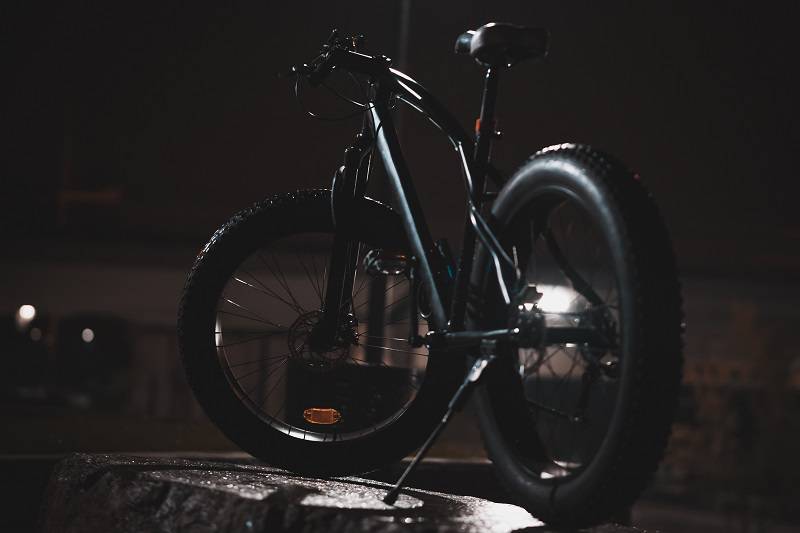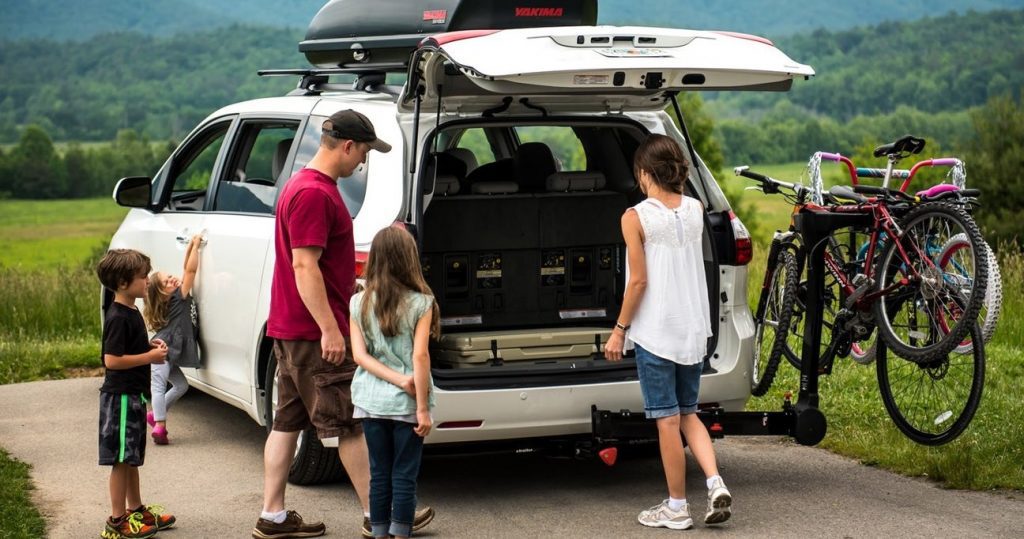
The popularity of cycling in the United States continues to rise, with more individuals and families embracing it as a form of recreation, exercise, and even transportation. This increased interest in cycling has naturally led to a greater need for effective and convenient ways to transport bicycles, especially for those with the versatile space of an SUV. Among the various options available, hitch-mounted bike racks have emerged as a preferred choice for many SUV owners due to their ease of loading, enhanced security, and potential to carry a larger number of bikes compared to other types like roof or trunk racks.
This report aims to provide a comprehensive guide for SUV owners seeking the best hitch bike racks for their needs, based on a thorough analysis of recent reviews and product information available in the United States. By examining the different types of hitch racks, key factors to consider during purchase, and a detailed analysis of the top-rated models, this report will empower SUV owners to make informed decisions and confidently transport their bikes on any adventure.
Understanding the Landscape of Hitch Bike Racks for SUVs
The market for hitch bike racks designed for SUVs offers a variety of styles, each with its own set of advantages and disadvantages. Understanding these different types is crucial for selecting the rack that best aligns with individual needs and preferences.
Platform Hitch Racks: Platform hitch racks are characterized by their sturdy, flat platforms or trays on which bicycles sit. These racks typically secure bikes using adjustable straps that fasten around the wheels, and often include an additional arm or clamp that secures the bike’s frame or front wheel. This design is known for providing exceptional stability and minimizing bike sway during transit. One of the primary benefits of platform racks is the ease with which bikes can be loaded and unloaded, a significant advantage, especially for heavier bicycles such as electric bikes (e-bikes). The lower loading height reduces the strain of lifting, making it accessible for a wider range of users.
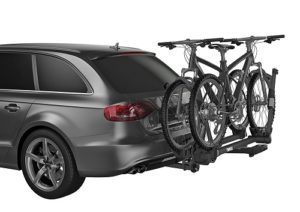
Furthermore, many platform racks are designed to avoid direct contact with the bike’s frame, which is particularly beneficial for protecting the integrity and finish of carbon fiber frames or custom paint jobs. While platform racks offer numerous benefits, they tend to be bulkier and heavier than hanging racks, which can make storage more challenging. They also often come with a higher price tag due to their robust construction and advanced features. The increasing popularity of e-bikes, as noted in indicates a significant market trend favoring platform racks.
Hanging Hitch Racks: Hanging hitch racks utilize arms that extend horizontally from the hitch receiver to support bicycles by their top tubes. Bikes are then secured to these arms using straps or cradles that fit around the frame. The primary advantages of hanging racks are their typically more compact size and lighter weight, making them easier to store when not in use. They are also generally more affordable than platform racks, appealing to budget-conscious consumers. However, hanging racks can present some drawbacks. Bikes may sway during travel, potentially leading to contact and damage, especially if multiple bikes are loaded.

Furthermore, not all bike frame designs are compatible with hanging racks. Bikes with step-through frames, kids’ bikes, or some full-suspension mountain bikes often require a top tube adapter bar to create a suitable hanging point. The direct contact with the bike frame inherent in hanging rack designs, as noted in , might be a growing concern for owners of high-value bicycles, particularly those with carbon fiber frames, where any abrasion could compromise the frame’s integrity.
Hitch Bike Racks with Specialized Features: In addition to the basic platform and hanging styles, many hitch bike racks come equipped with specialized features designed to enhance convenience and security for users.
-
- Integrated Locks: Some racks include built-in locking systems, typically featuring cable locks that can be threaded through the bike frames and secured to the rack, along with locks that secure the rack itself to the vehicle’s hitch receiver. This offers a convenient first line of defense against theft.
- Tilt-Down Mechanisms: Recognizing that SUV owners often need access to their vehicle’s rear cargo area, many hitch racks are designed with a tilt-down mechanism. This feature allows the user to tilt the entire rack, with bikes still loaded, away from the vehicle, providing enough clearance to open the SUV’s liftgate or trunk.
- Swing-Away Mechanisms: For even greater accessibility to the rear of the SUV, particularly for vehicles with swing-out rear doors or for those who frequently need complete, unobstructed access to the cargo area, some premium hitch racks incorporate a swing-away mechanism. These racks pivot entirely to the side, away from the vehicle’s opening. The increasing availability of these specialized features, as seen in , reflects a market catering to evolving user demands for convenience and functionality.
Key Factors United States Users Consider When Purchasing an SUV Hitch Bike Rack
When selecting a hitch bike rack for an SUV in the United States, several key factors come into play, influencing the purchasing decisions of consumers.
- Hitch Receiver Size Compatibility (1.25″ vs. 2″): The majority of SUVs in the US with a factory-installed or aftermarket hitch receiver will have either a 1.25″ or a 2″ opening. Ensuring that the chosen bike rack is compatible with the SUV’s specific hitch size is paramount for a safe and secure connection. Some bike racks are designed to fit both sizes through the use of adapters, offering greater versatility, while others are engineered for a specific hitch size. The fundamental nature of this compatibility requirement, as highlighted in , makes it the initial point of consideration for any potential buyer.
- Number of Bikes to Carry: Determining the typical number of bikes that need to be transported is a primary consideration for users. Hitch bike racks are available in configurations ranging from single-bike carriers to those capable of carrying up to six bikes. Selecting a rack with the appropriate capacity ensures that all bikes can be transported safely and without exceeding the rack’s weight limits. This decision is directly influenced by the number of cyclists in the household or the size of the group with whom the user typically rides, making capacity a core functional requirement.
- Types of Bikes (e.g., road, mountain, e-bikes, fat bikes): The specific types of bikes that will be transported play a significant role in determining the necessary features of a hitch rack. For instance, the increasing popularity of e-bikes in the US market necessitates racks with higher weight capacities to accommodate their heavier frames and components. Similarly, fat bikes, with their significantly wider tires, require racks with wider wheel trays or adjustable straps to ensure a secure fit. Owners of expensive bikes, particularly those with carbon fiber frames, often prioritize platform racks that avoid direct contact with the frame to prevent potential damage. The diverse range of bike types now owned by consumers, as reflected in the market offerings, means that users must carefully consider the compatibility of the rack with their specific bicycles.
- Ease of Installation and Removal: For many users, particularly those who do not intend to leave their bike rack permanently attached to their SUV, the ease of installation and removal is a crucial factor. Features such as tool-free installation systems, as seen in the Thule T2 Pro XTR , and lighter overall rack weights, as with the Kuat Transfer v2 , can significantly enhance user convenience. The value placed on convenience, as suggested by the emphasis on easy installation and removal in reviews , indicates a preference for user-friendly designs.
- Durability and Build Quality: A hitch bike rack represents a significant investment for most users, and they expect it to be durable and reliable over the long term, capable of withstanding regular use and exposure to various weather conditions. High-quality materials, such as steel and aluminum, and robust construction are key indicators of a rack’s durability. The importance of a sturdy rack that can reliably transport bikes without risk of damage is highlighted in , with some users specifically praising the all-metal construction of brands like 1Up USA.
- Security Features: Protecting bicycles from theft is a significant concern for owners. Hitch racks that include integrated locking cables and hitch locks, as found in models like the Thule T2 Pro XTR and Kuat Transfer v2 , offer a convenient and effective way to deter opportunistic thieves. The presence of these features provides users with added peace of mind, especially during stops on longer journeys.
- Access to the Rear of the SUV (Tilt or Swing-Away Mechanisms): For SUV owners, maintaining convenient access to the vehicle’s rear cargo area is often a high priority. Tilt-down mechanisms, as featured on the Thule T2 Pro XTR and Kuat Transfer v2 , and swing-away features, as seen on the RockyMounts BackStage , address this need by allowing the user to open the liftgate or trunk without completely unloading the bikes. This functionality is particularly valuable for SUV owners who frequently need to access their cargo space while transporting bikes.
- Budget and Price Range: The cost of hitch bike racks can vary considerably based on the type, features, and brand, ranging from more affordable options like the Swagman XC2 to premium models such as the Thule T2 Pro XTR and RockyMounts BackStage. Users must consider their budget and weigh it against the features and level of quality they desire. The wide range of prices available allows consumers to find a balance between their financial constraints and their specific bike transportation needs.
Our Top-Rated Hitch Bike Racks for SUVs
Based on recent reviews and product information, the following hitch bike racks stand out as top-rated options for SUV owners in the United States:
1). Thule T2 Pro XTR: The Thule T2 Pro XTR consistently ranks as a top overall choice in numerous reviews. Its user-friendly design, versatility in accommodating various bike types, and durable construction make it a premium option for SUV owners.

- Capacity: 2 bikes (up to 4 with add-on for 2″ receiver)
- Weight Capacity: 60 lbs per bike
- Hitch Size: 1.25″ and 2″
- Bike Compatibility: Road, mountain, fat bikes, e-bikes
- Wheel Size: 20″ to 29″
Tire Width: Up to 5″
Integrated Locks: Bike and hitch locks
Tilt Function: HitchSwitch lever for easy tilt-down access
Material: Metal frame, robust plastic components
Rack Weight: ~52 lbs
2). Kuat Transfer v2: The Kuat Transfer v2 is widely recognized as a “Best Value” option , offering a strong balance of essential features and performance at a more accessible price point.
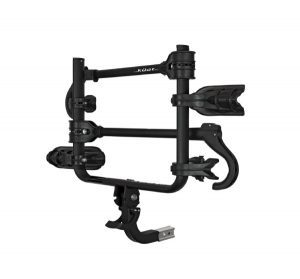
- Capacity: 2 bikes (up to 3 with add-on for 2″ version)
- Weight Capacity: 60 lbs/bike (2″), 40 lbs/bike (1.25″)
- Hitch Size: 1.25″ and 2″
- Bike Compatibility: Road, mountain, e-bikes, fat bikes (w/ strap)
- Wheel Size: 18″ to 29″
- Tire Width: Up to 5″ (with accessory strap)
- Integrated Locks: Semi-integrated cable lock, hitch security
- Tilt Function: Foot-operated lever for tilt-down access
- Material: Steel frame
- Rack Weight: ~37 lbs (2″ version)
3). Swagman XC2: The Swagman XC2 is consistently highlighted as the “Best Budget” pick in hitch bike rack reviews, providing an affordable and simple solution for transporting up to two bikes.
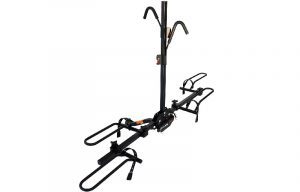
- Capacity: 2 bikes
- Weight Capacity: 35 lbs per bike
- Hitch Size: 1.25″ and 2″
- Bike Compatibility: Most frame sizes (adapter may be needed)
- Wheel Size: 20″ to 29″
- Tire Width: Up to 2.5″ (fat bike trays sold separately)
- Frame Contact: Ratcheting hooks on top tube
- Vehicle Access: Center arm folds down when bikes are not mounted
- Material: Steel
- Rack Weight: ~28 lbs
4). Yakima RidgeBack 4: The Yakima RidgeBack 4 is a popular hanging-style hitch bike rack praised for its ease of use and ability to carry up to four bikes.
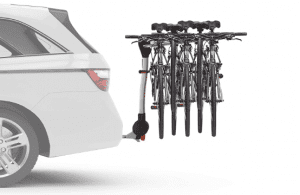
- Capacity: 4 bikes (also in 2 and 5 bike versions)
- Weight Capacity: 40 lbs per bike
- Hitch Size: 1.25″ and 2″
- Bike Compatibility: Traditional frames (adapter needed for others)
- Wheel Size: 20″ to 29″
- Tire Width: < 5″
- Integrated Locks: SpeedKnob locks rack to car
- Tilt Function: UpperHand lever for tilt-down access
- Material: Steel
- Rack Weight: ~35 lbs
5). RockyMounts BackStage: The RockyMounts BackStage is a distinctive platform hitch rack celebrated for its 180-degree swing-away feature.
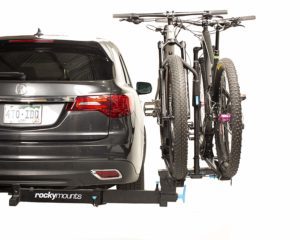
- Capacity: 2 bikes
- Weight Capacity: 60 lbs per bike
- Hitch Size: 2″ only
- Bike Compatibility: Road, mountain, fat bikes
- Wheel Size: 20″ to 29″
- Tire Width: Up to 5″
- Frame Contact: No frame contact
- Vehicle Access: 180-degree swing-away, 30-degree tilt-down
- Integrated Locks: Locking hitch bolt and cable lock
- Material: Steel and aluminum
- Rack Weight: ~59 lbs
6). Thule EasyFold XT 2: The Thule EasyFold XT 2 is a premium, fully foldable platform rack particularly well-suited for e-bikes due to its high weight capacity and optional ramp.
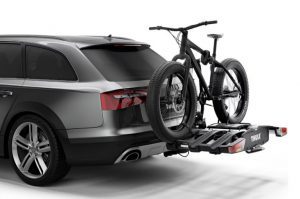
- Capacity: 2 bikes
- Weight Capacity: 65 lbs per bike
- Hitch Size: 1.25″ and 2″
- Bike Compatibility: All types, great for e-bikes and fenders
- Wheel Size: 20″ to 29″
- Tire Width: Up to 3″ (4.7″ with optional straps)
- Frame Contact: Clamps on frame
- Vehicle Access: Foot pedal tilt with bikes loaded
- Storage: Fully foldable, integrated wheels and handle
- Security: Bike and receiver locks
- Material: Aluminum and steel
- Rack Weight: ~45 lbs
Guide to Choosing the Right Hitch Bike Rack for Your SUV: A Step-by-Step Approach
Selecting the ideal hitch bike rack for your SUV requires careful consideration of your individual needs and priorities. Start by assessing how many bikes you typically need to carry and the types of bikes you own, taking into account their weight, frame material (especially if you own carbon fiber bikes), and tire size (particularly if you have fat bikes). Consider how frequently you plan to use the rack; occasional users might prioritize budget-friendly options, while frequent riders may value durability and advanced features.
The importance of easy access to the rear of your SUV should also be evaluated. If you frequently need to access your cargo space, a rack with a tilt-down mechanism, such as the Thule T2 Pro XTR, Kuat Transfer v2, or Thule EasyFold XT 2, or even a swing-away feature like the RockyMounts BackStage, would be highly beneficial. Establish your budget for a bike rack, keeping in mind that prices can range from under $200 to over $800 or even $1000+ for high-capacity or specialized models. Finally, determine the importance of security features; if you often leave your bikes unattended, integrated locks or the option to use robust aftermarket locks are crucial.
Next, match these needs with the features of different bike racks. Ensure that the rack you choose is compatible with your SUV’s hitch receiver size (1.25″ or 2″). Select a rack with a weight capacity that can safely accommodate all the bikes you plan to carry, especially if you own e-bikes, which can be significantly heavier than traditional bikes. Consider the tire width and wheel size compatibility, particularly if you ride fat bikes or have kids’ bikes with smaller wheels. Decide whether a platform rack (offering stability and often no frame contact) or a hanging rack (typically more compact and affordable) is better suited to your bike types and your preferences regarding loading and potential frame contact. Evaluate the necessity of specialized features like tilt, swing-away, and integrated locks based on your individual circumstances.
Consider your budget and remember that while higher-priced racks often offer more features and potentially greater durability, there are also excellent options available at more moderate price points. For instance, if you primarily carry e-bikes and value ease of loading and storage, the Thule EasyFold XT 2 is a strong contender, despite its premium price. If you’re a family needing to transport four bikes and are looking for a balance of capacity and affordability, the Yakima RidgeBack 4 is a solid choice. For those who require complete and easy access to the rear of their SUV, especially if they have a van or camper van, the RockyMounts BackStage, with its unique swing-away feature, is an ideal solution.
Selecting the Ideal Hitch Bike Rack for Your SUV Adventures
Choosing the right hitch bike rack is a crucial step for any SUV owner looking to safely and conveniently transport their bicycles. The market offers a diverse range of options, each with its own set of strengths and features. This report has highlighted some of the top-rated hitch bike racks for SUVs in the United States, including the versatile and user-friendly Thule T2 Pro XTR, the value-oriented Kuat Transfer v2, the budget-friendly Swagman XC2, the high-capacity Yakima RidgeBack 4, the uniquely accessible RockyMounts BackStage, the e-bike-friendly and foldable Thule EasyFold XT 2, and the high-capacity, off-road-ready 1Up USA Recon Rack 6.
Ultimately, the best hitch bike rack for you will depend on your specific needs, the types of bikes you own, your budget, and your priorities regarding features like rear vehicle access and security. We encourage you to carefully consider these factors and explore detailed product information to make a well-informed decision that will enhance your cycling adventures for years to come.
